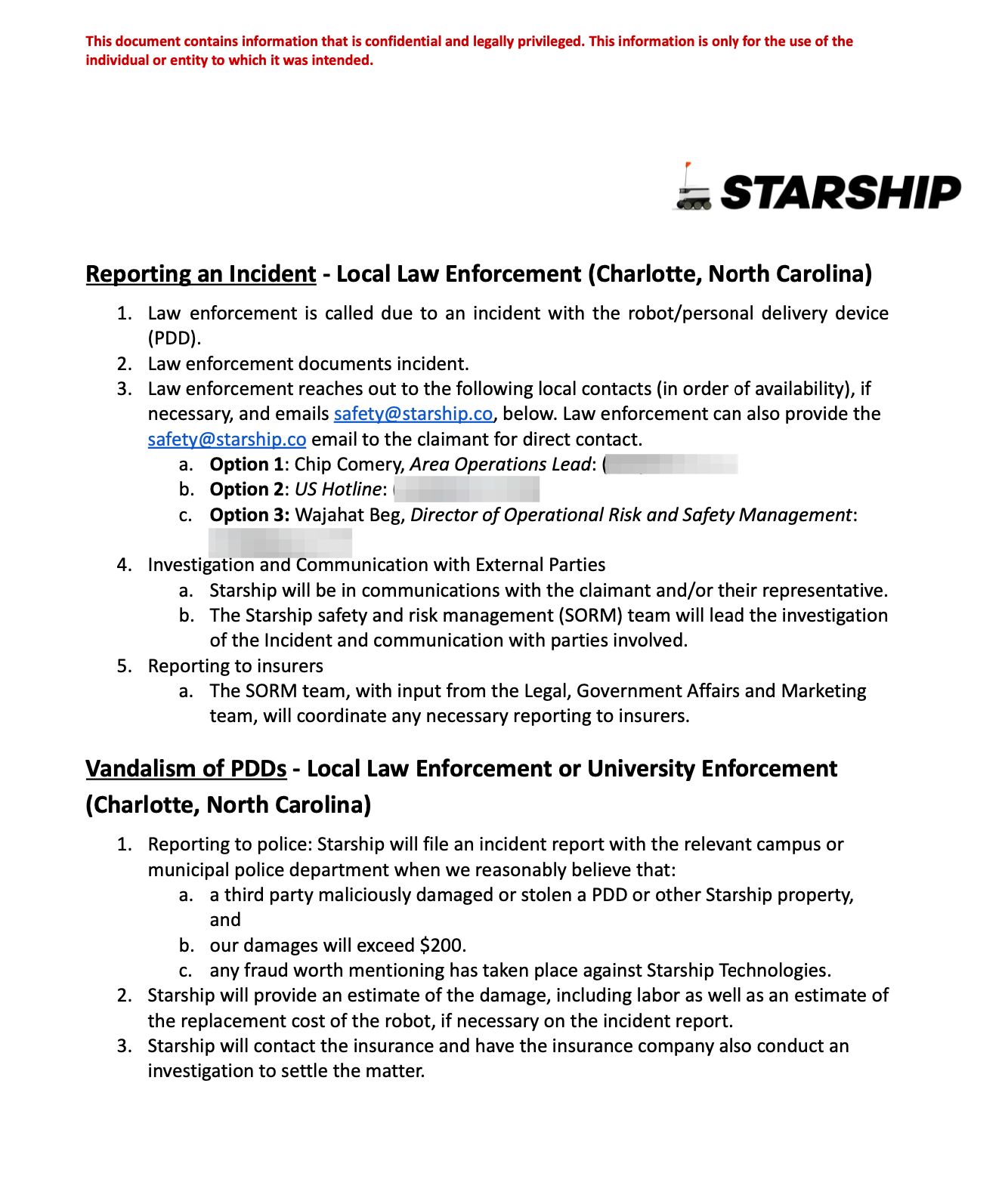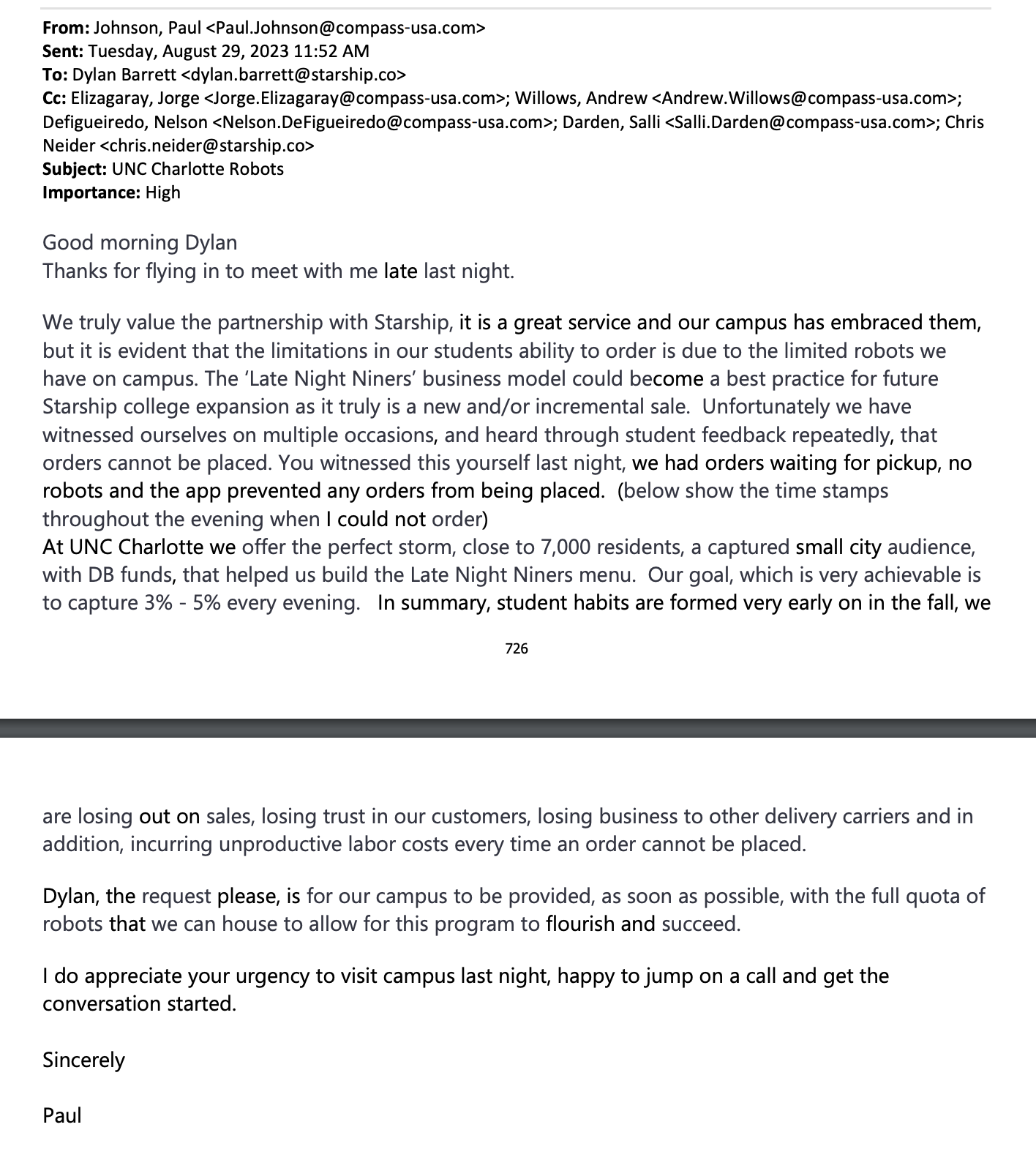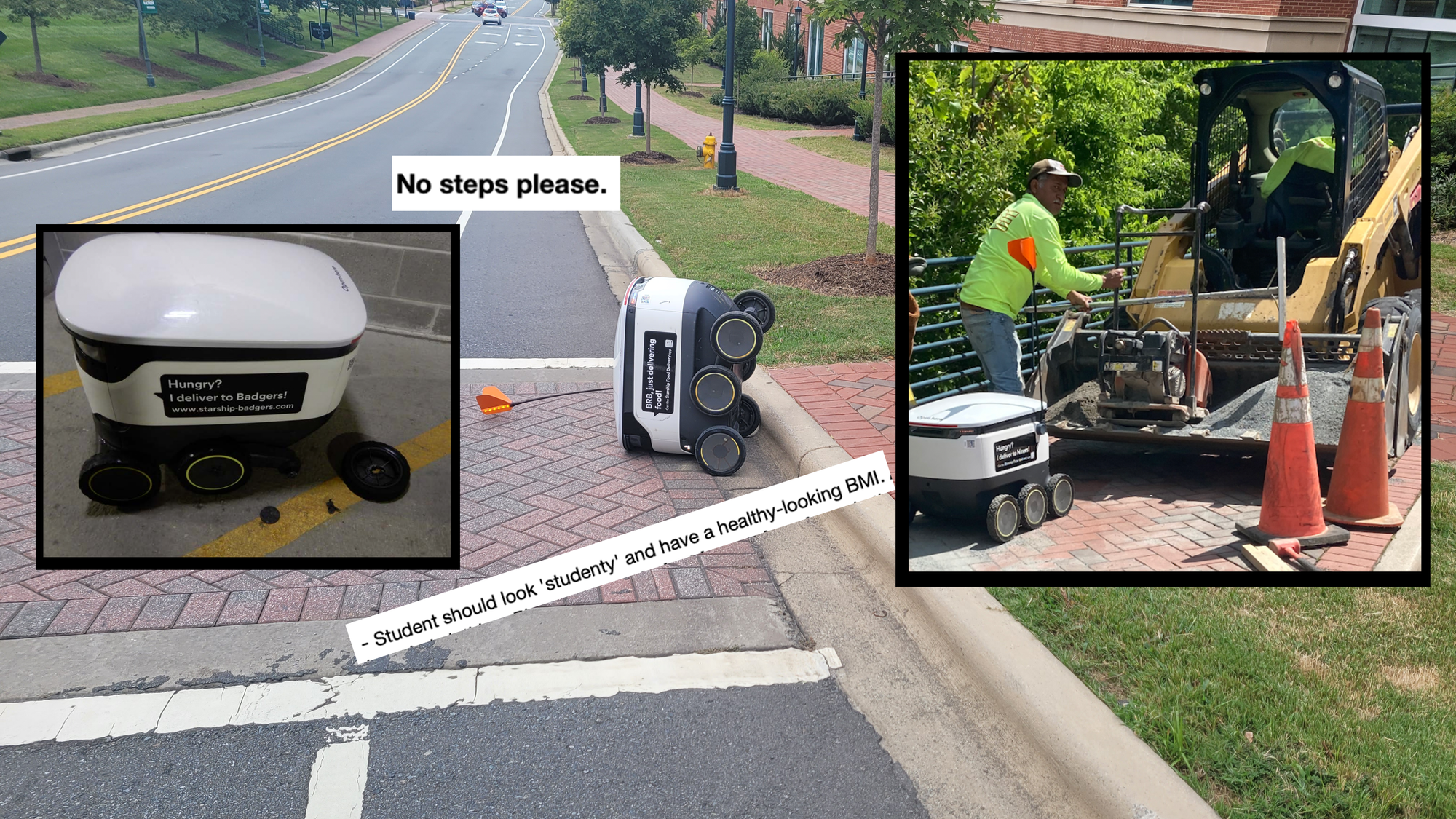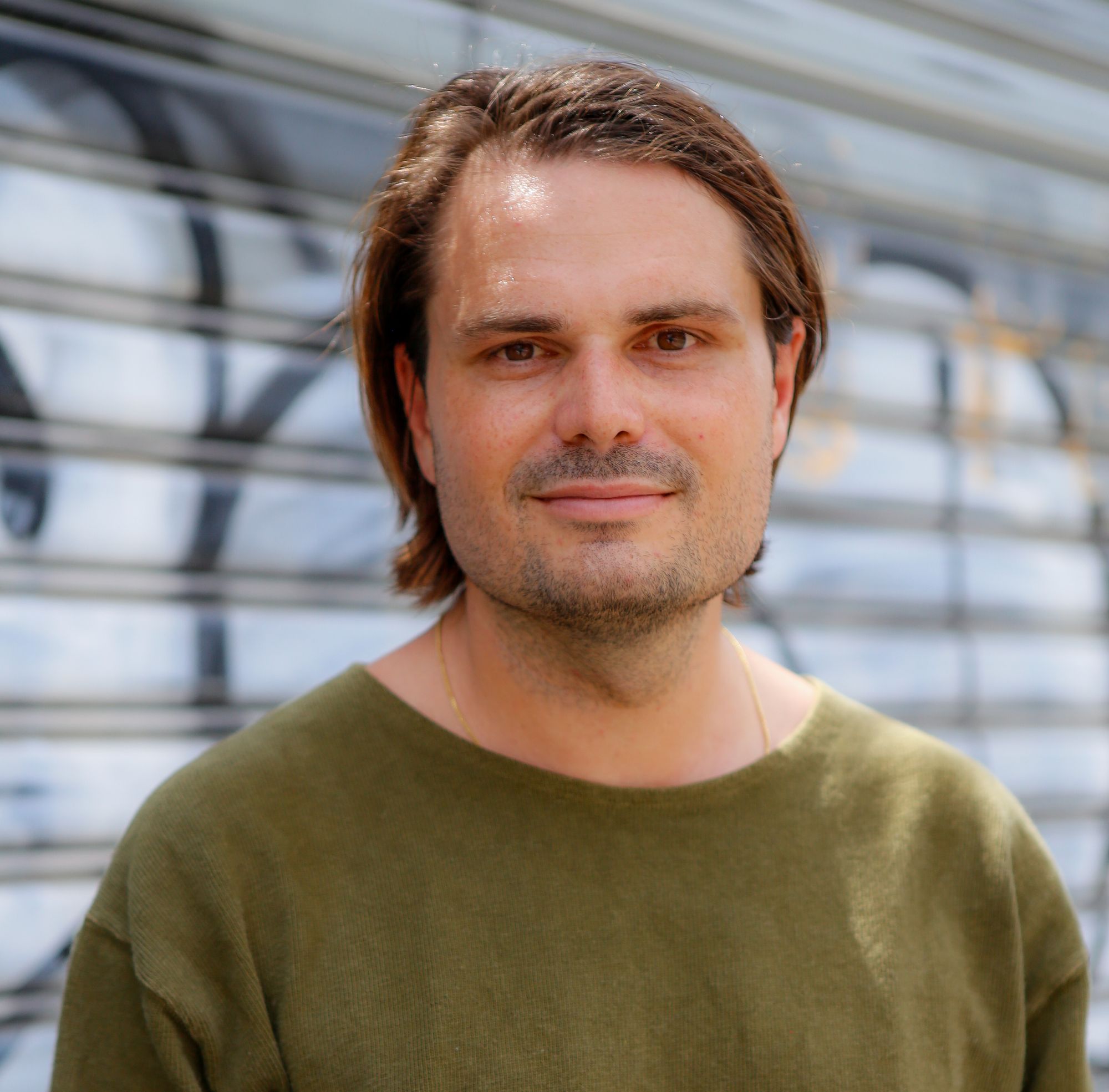Subscribe
A food delivery robot company instructed a public university to promote its service on campus with photographs and video featuring only students who “have a healthy-looking BMI,” [body mass index] according to emails and documents I obtained via a public records request. The emails also discuss how ordering delivery via robot should become a “habit” for a “captured” customer base of students on campus.
These highly specific instructions show how universities around the country are going to extreme lengths to create a welcoming environment on campus for food delivery robots that sometimes have trouble crossing the street and need traffic infrastructure redesigned for them in order to navigate campus, a relatively absurd cache of public records obtained by 404 Media reveals.
Starship delivery robots are currently semiautonomously performing the critical public service of driving orange chicken from Panda Expresses, Wendy’s, and other restaurants on campus to dorm rooms at 32universities across around America: “Over 5 million autonomous deliveries now completed! Thousands of Starship delivery robots are operating globally, every day,” the company’s website notes.
Documents I obtained from the University of North Carolina at Charlotte show that universities are instructed by Starship to stage and take glamorous publicity photos of the robots that show “as many robots as possible in front of a university landmark,” and for the photos should stage a fake autonomous delivery that is made to look autonomous but is not. University police, meanwhile, are instructed to immediately notify the company if the robot is involved in some sort of crime or safety incident, and the company requests that it “lead” the investigation of the incident.
University police and employees at the University of North Carolina at Charlotte’s IT department saw the robots as potentially roving spies, and asked the company “how to obtain footage if a crime was committed with a robot in the area” and “will the police have access to the video system?” Starship told the university that it is “sensitive to the importance of privacy” and said it “has implemented features aimed at preventing any incidental recording of identifiable individuals … Starship policy prohibits sharing video data with law enforcement outside of limited situations involving the prevention or detection of a crime.”
In the fall, I filed public records requests with about a dozen public universities around the country that have deals with Starship, which exclusively delivers food on campuses. I filed the requests immediately after learning that another food delivery company, Serve Robotics, provided video footage from its robots to the Los Angeles Police Department to help convict a man who tried to steal one of the robots. I theorized that perhaps similar deals were in place between Starship and university police departments. Soon after I filed the requests, a Starship robot at Oregon State University was subject to a bomb threat.
This article focuses primarily on Starship’s partnership with the University of North Carolina at Charlotte because the documents show prelaunch planning and the issues that popped up after the service became operational.
The documents also highlight the extent to which food services has become a profit center for universities and their contractors. Starship’s contract isn’t actually with UNC Charlotte, it’s with a company called Compass USA, a company which provides food services for the university. Because of this third-party relationship, UNC Charlotte’s spokespeople claimed that they did not have answers to many of my questions. Many additional documents, such as the specific contract between Compass USA and Starship are likely exempt from FOIA because they are between two private companies. I was able to obtain an email between Compass USA and Starship that discussed how to extract more revenue from student customers, for example, only because it was later forwarded to university officials. The emails show nonetheless that UNC Charlotte has been heavily involved and concerned with Starship’s rollout on campus, and show Compass USA fighting with Starship over potentially lost revenue because Starship had issues with the rollout of its robots.
“UNC Charlotte does not have a direct relationship with Starship. The relationship is managed through the University's dining provider, Compass Group USA, Inc.,” a UNC Charlotte spokesperson told me. “No other agreements exist between Starship and any entity on campus. The University is pleased to provide this service as one of many options for our students on campus.”
Compass USA (whose campus and schools dining arm is called “Chartwells,” acknowledged a request for comment and said it would respond to me before my deadline of last Friday. It didn’t provide comment by that deadline and did not respond to a follow-up email and text message sent Tuesday. Starship’s communication team and an external public relations firm it worked with on the UNC Charlotte launch ignored five emails with specific questions about the documents. In October, it responded to a separate request for comment I sent about the Oregon State University threat in which it said “we are thankful that there was never any threat to public safety because this was a hoax.”
“Student should look ‘studenty’ and have a healthy-looking BMI”
Starship was set to launch at UNC Charlotte in March of last year. In the leadup to launch, Starship sent the university a “photography brief” that explained the types of promotional photos the university should take and what it would approve. These shots have been used to promote the service on UNC Charlotte’s website and in presentations to university executives that were also included in the cache of documents I obtained.
Most strikingly, the document requests images of a “student receiving delivery,” but stressed that the “student should look ‘studenty’ and have a healthy-looking BMI.” Other requests were a “Fleet Shot” with “as many robots as possible in front of a University landmark. When arranging robots, an arrow formation usually works best, focusing the eye on the landmark behind.”
The photographer was instructed that photos should “avoid any steps/stairs in the background. This highlights the fact that our robots can’t climb them - yet!” After launch, Starship robots would repeatedly tip over when they jumped off of curbs, the documents show. The photography brief also requests a “delivery to Mascot” and “delivery to President.” There are multiple email threads discussing how to convince Chancellor Sharon Gaber to do the shoot. Gaber later tweeted about the robots, and another university executive told UNC Charlotte’s marketing team that “the chancellor saw all the good media coverage for [Starship’s partnership with] Eastern Carolina University and that she is expecting something as big in our marketing area.” Photos of the robot with UNC Charlotte’s mascot Norm the Niner have shown up in various marketing materials I obtained.
The same marketing materials brief also asks the photographer to shoot video b-roll for marketing purposes. It instructs them not to use the robot in autonomous mode for the shoot, and says that a Starship robot should be operated manually with a Playstation 4 controller during promotional shots. It says that despite being manually controlled, “the robot should be driven exactly how it behaves autonomously,” that they should “try and get shots where students ignore the robot as it passes by. Just a ‘normal day.’” The robot voice that says “Here’s your delivery. Have a nice day” could be sent as a separate sound file to edit into a promo video after the fact, the document says.
The document also states that, in manual mode for the promotional video, “the robot would cross roads safely, waiting to assess the traffic before crossing, rather than rushing across a road,” which foreshadows problems that the university had after launch.
Before launch, Starship also sent the university a “Safety & Incident Management Document,” which it instructed the university to share “with the campus safety teams.” This document explains at length that Starship cares about safety and that it wants to “promote a positive, transparent reporting culture through ‘no-blame’ policies,” and that, should a safety incident occur, police should document it and then immediately contact the company so that the company itself can “lead” whatever investigation needs to be done.

“Law enforcement reaches out to the following local contacts [at Starship],” the document states in its list of steps for documenting an incident. Starship will then investigate, it says: “Starship will be in communications with the claimant and/or their representative. The Starship safety and risk management (SORM) team will lead the investigation of the incident and communications with parties involved.” Starship says it will also file an incident report with police anytime more than $200 worth of damage is done to one of its robots.
Documents I obtained from the University of Wisconsin-Madison show that a police officer there arrested a drunk 21-year-old student for “intentional criminal damage to property” because the student “was carrying a UW Dining Starship robot and dropped it causing to break,” and ran from a cop who witnessed this. The student broke a $19 wheel on the robot which ultimately cost $74 to fix including labor, according to a quote Starship provided to UW-Madison. At the University of California, Irvine, police wrote up an incident in which a student had “glued flyers” and written on four Starship robots as part of a protest that caused $275 worth of damage, according to a police report and emails I obtained. “Starship is desirous of prosecution,” the police report reads. Images of the robots were not included in the documents I received, but the alleged vandalism happened during a widespread student strike at UC-Irvine in which students were protesting extremely low wages for graduate students.
The documents I obtained from UNC Charlotte also discuss the budgeting and design of a “Starship Robot Service Hub,” which the university said would cost $30,000 to design and roughly $110,000 to extend utilities to. It is unclear who paid for this, but UNC Charlotte employees are the only ones on the email threads talking about this.
‘Street Crossing is an issue’
Immediately after launching in March 2023, the university noticed that the robots often could not cross the street.
“Starship Team, Street crossing is an issue we identified since launch day on 3/1,” an email from Jorge Elizagaray, Director of Operations for Compass USA at UNC Charlotte, wrote to Starship. “Robots are having an incredible difficult time to cross streets, this issue affects student traffic by crosswalks, sidewalk congestion, extended delivery times, quality of the product, and ultimately customer satisfaction.” Student feedback included in his email was “Rachel’s order took 13 minutes to cross the street,” “I personally timed two yesterday and they were on average 10-15 min waiting for someone (remotely?) to help them to cross the street” and “It sat at the intersection up here on Cameron of over 10 minutes. It could not figure out how to cross the street. Mark went out and helped it.”
A Starship employee said in response that “we have a dedicated remote team in which they solely monitor crossings across all campuses. They help break up robot traffic jams and manually cross streets when they’re alerted robots are taking too long to cross on their own.” Another email said the university was told by Starship “that the robots are 99 percent autonomous and the 1 percent is the call center that’s always alerted if a robot gets stuck … so the idea is for staff to let them be.”
Eventually, the university and Starship determined that the robots were having trouble because specific crosswalks were set to display walk signs only after a human pushed the cross button, and the robots couldn’t navigate the manual crosswalk. The university asked campus police to alter a series of crosswalks and traffic lights so that they would be more easily navigable by robots.
“We’re unfortunately having issues with the robots crossing the street at some intersections without major delays, causing them to stack up and take a considerable amount of time to cross,” the email from a UNC Charlotte employee to UNC Charlotte police reads. “We reached out to Starship to see if they had recommendations on how to address this issue. They suggested that we look into converting the manual crosswalk push buttons to automatically show the walk signal when the opposing light is green. Is this something that you would consider? We've been told that it would make a huge positive impact because the robot's sensors/cameras are looking for that walk signal.”
“I'm trying to see if the police can automate our walk signals to help out the robots, per Starship's recommendation,” another email reads.
Doug Lape, associate vice chancellor for business services at the university, said in an email at the end of March that the university was working on redesigning some traffic lights to have “specialized road side units” that communicate with autonomous vehicles “to let the vehicle know what stage the signal is in,” and suggested this system could also work for Starship.
Several days later, Lape sent another email in which he’d been notified of a “Robot face plant” at a specific intersection, and asked Elizagaray to “get with Starship and have them remove this crossing from the robots’ GPS route inventory” because it had jumped a curb where there was no ramp. Several days after that, on April 10, a Starship robot got “stuck at the police station” for “3+ hours.” On April 12, university officials noticed that two robots had begun driving outside of the geographic boundaries of the campus in a “no delivery one.”
“Why are robots crossing John Kirk [Drive] and/or going outside our boundary areas?,” Drew Averitt of the university’s parking and transportation services wrote in an email. “Are these robots manually controlled and if so why have we not discussed an expansion request? … Our concern is there is a law that does not allow us (campus) to compete with the community so I do not want us to get called out by someone in the community and jeopardize this program.” A Starship employee told the university “it is not possible for them to navigate on unmapped pathways.”
A month later, in May, the university realized after a robot drove through a work zone, that it would need to keep track of any “proposed sidewalk blockages” so that the robots could be proactively notified because caution tape used for humans is generally placed as a level for human eyes, not for robotic cameras: “There was caution tape installed to close the sidewalk. The tape was at about 3 feet up which the robot didn’t see which allowed it to continue up to the work zone,” Averitt wrote in an email. “Robots will recalculate when they find obstacles but we can also reroute or block out paths when necessary … it would be helpful to know of any proposed sidewalk blockages.”
A ‘Captured’ Customer Base of Students With Dining Plans
Over the summer, UNC Charlotte and Starship worked to improve service and fix various issues, which included the crosswalk situation and making the robots able to charge autonomously, without students having to plug them in. “They’ll still have student labor to clean them and let them into the building,” one email noted. There are a few emails about getting “automatic doors” because the university had begun leaving a specific door where the robots were stored propped open at night: “Keeping the door propped open is not good from 1) a security standpoint and 2) a sanitary standpoint (bugs),” an email reads.
A repeated line of questioning in the emails among university staff was the fact that they believed they did not have enough robots to meet demand from students, and that wait times were too long. They repeatedly asked Starship to give it more robots, and wanted to know what metrics they needed to hit in order to get more robots (Starship demurred and said there are “multiple factors” that go into deciding how many robots are at any given campus).
This all came to a head when students came back to campus at the start of August 2023. The university launched a “new late-night menu” available only through the Starship app from 8 pm through 1 am called “Late Night Niners.” The university had problems keeping up with robot delivery demand for this service, which resulted in a stern email, and a seemingly emergency late-night meeting between Compass and Starship in which the university again demanded additional robots. Compass’s email also highlights the actual purpose of the robots, which is to create a “habit forming” service that makes money from a “captured” customer base of students, many of whom have “declining balance” (DB) portions of their prepaid university meal plans that can be used with Starship. A presentation pitched within the university by Compass champions Starship as being cheaper than Grubhub in part because students don’t have to tip.

“We truly value the partnership with Starship, it is a great service and our campus has embraced them, but it is evident that the limitations in our students ability to order is due to the limited robots we have on campus. The ‘Late Night Niners’ business model could become a best practice for future Starship college expansion as it truly is a new and/or incremental sale,” the Compass email to Starship reads. “Unfortunately we have witnessed ourselves on multiple occasions, and heard through student feedback repeatedly, that orders cannot be placed. You witnessed this yourself last night, we had orders waiting for pickup, no robots and the app prevented any orders from being placed.”
Compass told Starship that the university has a “captured” clientele of students with money to burn on their dining cards, that they expected 3-5 percent of the university’s 7,000 students to order delivery on any given day, and that Starship was ruining a great opportunity by not providing enough robots.
“At UNC Charlotte we offer the perfect storm, close to 7,000 residents, a captured small city audience, with DB funds, that helped us build the Late Night Niners menu. Our goal, which is very achievable is to capture 3% - 5% every evening,” the email from Compass to Starship, which was forwarded to university officials, reads. “In summary, student habits are formed very early on in the fall, we are losing out on sales, losing trust in our customers, losing business to other delivery carriers and in addition, incurring unproductive labor costs every time an order cannot be placed. Dylan, the request please, is for our campus to be provided, as soon as possible, with the full quota of robots that we can house to allow for this program to flourish and succeed. I do appreciate your urgency to visit campus last night, happy to jump on a call and get the conversation started.”
In September, a month into the semester, a student was hit by a car and broke multiple bones in her face. According to a police report, the driver “stated that he had a flashing yellow left turn traffic signal and as he was making his turn, he saw the Starship delivery robots and was concerned that they were going to drive out into the roadway,” was distracted, and hit the student. There are no emails about this incident included in the documents I received. The same day, though, university officials were trying to figure out what happened and do damage control in an incident with a student who posted a thread on Reddit titled “Starship robots holding food hostage,” in which a student with very little money apparently spent the last of it on Bojangles and was unable to get the food out of the robot: “He attempted to unlock and it didn’t respond. He tried a couple different things but nothing. Then it timed out and took off. Taking his food with it. He was out $15 and had no food,” the post reads. “There are students with little to no food and Starship is just contributing to that insecurity.” The post is one of the most upvoted about Starship on the r/UNCCharlotte subreddit and is filled with people who say they don’t like the robots.
“Dylan [from Starship] asked if we could identify the unfortunate student,” one email reads.
The other top post about Starship on the subreddit is from last month and shows seven Starship robots sitting at an intersection: "That particular corner is bad for clogging as they have a hard time crossing the road there."
"FOIA EXCLUSION LANGUAGE"
I have found it exceedingly difficult to get basic documents about Starship from most of the universities that I’ve filed requests with. The documents I ultimately got from the University of North Carolina at Charlotte give two clues as to why that may be: Many universities hire third-party, for-profit dining services contractors to do on-campus food services. Starship’s contract at UNC Charlotte is with a conglomerate called Compass USA, whose on-campus dining company is called Chartwells. This third-party relationship means that lots of documents about on-campus activities at public universities are not technically subject to public records requests.
Beyond that, Starship also asked Compass and the university to write FOIA exemptions into any contract that does exist, which in some states makes it much harder to get public records even when they would normally be subject to FOIA.
Starship declined, for example, a UNC Charlotte “data reporting request” about its operations on campus “even with FOIA exclusion language in the statement of work,” a Starship employee told UNC Charlotte. “we have significant IP that we need to protect and much of this data can be used to derive details about our solution we do not want to have exposed.” I include this aside because my requests at other universities have simply been denied, have returned a very small number of documents, or have been tied up by FOI officers who claim that my requests are too difficult to process.


